|
|
|
|||
|
|
||||
|
|
||||
| The Smoky Addiction | ||||
|
|
HOME | SITE MAP | FORUM | CONTACT |
|
||
|
ABOUT | MOTORS | MODELS | ARCHIVE | HISTORY | STORE | FAQ | LINKS
|
|
|
|
|
|
|||||||||||||||||||||||||||||||||||||||||||||||||||||||||
 The Smoky Addiction 2
(February 2005)
The Smoky Addiction 2
(February 2005)by Roger Simmonds Reprinted from SAM 35 Speaks, February 2005 Profile Models Though I have not exactly come to love all-sheet models, I am starting to appreciate their virtues: they are a lot of fun, they can fly in an realistic manner and are a simple cost effective way of getting some very interesting shapes into the wide blue yonder. Howard Metcalfe, who has a fine fleet of ‘profile scale’ models, is partly to blame for my change of heart. So here are a number of all-sheet scale models, beginning with Bob Linn’s Short Sherpa (Aeromodeller, Jan. 1956), a nice design that could also be flown as a catapult glider. |
|
|||||||||||||||||||||||||||||||||||||||||||||||||||||||||

An Atom 35 (not a 50) was recommended for the original, so an L1 or L2 LT would be equally suitable. Note that the undercarriage has been sensibly left off so that the lines of the original are better displayed. The Sherpa was a test bed for the PD.1 four-engine bomber [right] which is even shapelier, and a more sophisticated scale model of this ‘might-have-been’ is well worth considering. The second all-sheet offering is modern: Howard’s Lockheed F-104 Starfighter [right]. This has many interesting features worth discussing at some length. First, note the motor mount (a Jet-X 50 or Rapier can be fitted) and the thrust deflector tab [below right]; second, there is anhedral on the wings (which I suspect have been enlarged just a little); and third, it is launched by catapult – the hook can be seen well forward beneath the canopy. Howard writes about his creation: “I don’t think it knows it has anhedral because it flies quite well on a 130 mN Rapier L2 and is perfectly stable until it stalls and flicks into a ‘falling leaf’ cum spin. Even so it is very pretty to watch, and provided there is sufficient height it will recover and fly on as if nothing has happened, though the pilot probably feels a bit sick”. This is, of course, a classic description of the “roll coupling” that afflicted many early supersonic prototypes like the Bell X-2, Super Sabre, and, especially, the Douglas X-3 we featured last month. It is interesting that even profile scale models can realistically replicate some of the idiosyncrasies of their prototypes. Howard continues: “I prefer to catapult launch it as it needs a good bung and is not easy to hand launch as the motor and trim tab get in the way. The resultant fast climb-out is a joy to watch, however it will just as easily ‘spear in’ if you get it wrong or it hits turbulence from which it struggles to recover … the hardish 3/16" balsa fuselage has paid off in this respect even if the fin and tailplane often depart on such arrivals. The 0.75mm aluminium strip ‘downthrust tab’ may appear to be at far too an extreme angle, but I kept bending it until I got the effect I wanted – a fast level flight and no looping. The glide is not brilliant and whilst it is fast with an L2 it is spectacular with a Jet-X 50”. The ‘downthrust tab’ is a convenient way of preventing the ‘zoom to doom’ or looping tendencies of models with a low thrustline without having to add lots of noseweight, and worth trying in the trough of a proper built up model. I was quite surprised that ordinary aluminium can withstand the direct blast of Rapier exhaust; it will certainly need to be cleaned of all the accumulated gunk regularly. Howard’s model is reminiscent of Paul Del Gatto’s North American X-15 for PAA-Loader. This, too, was by all accounts a spectacular performer. |
|
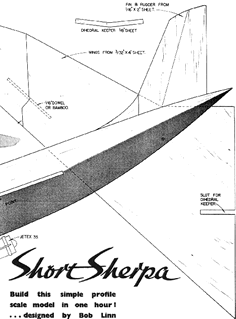
- Aeromodeller, Jan. 1956
 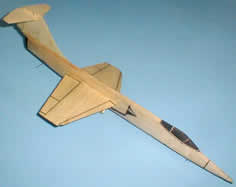  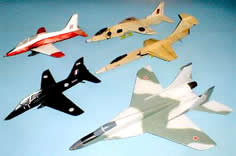
- photos by Howard Metcalfe
|
||||||||||||||||||||||||||||||||||||||||||||||||||||||||
|
|
|
|||||||
|
Howard also has meticulous facsimiles of the Jetex Wren and Sharky in his collection, and very nice they are too. However, as John Emmet reminded us in SAM Speaks a number of years ago, there were no plans, and in order to recreate these Jetex profile models, one needs access to a complete kit. [Jetex.org has Howard’s re-creation of the Sharky plan for download.] I can supply component outlines for some of these designs, including the Sharky and ‘Tailored Silhouette’ Javelin, but I haven’t yet found an example of the elusive Viper – or the even rarer M.7 Transonic Flying Boat; [right]. This kit is scarce, perhaps, because it was a ‘tie in’ or promotion of ‘The Net’, a really rather good sci-fi film released in the spring of 1953. The evocative advertisement [right] comes from the Aeromodeller, April 1953. Peter Cock tells the story of Mike Ingram (the M.7’s designer), Bert Judge, and himself going in Bert’s Ford Popular to the première in Leicester Square. They picked up a puncture around about Winchester, had trouble getting the spare wheel off because the nuts were rusty, and finally arrived at the Odeon to see only the last fifteen minutes. Then there was the return home through thick freezing fog. Happy days! It would be nice to see an M.7 flying again. Can anyone share a pristine example so that the component parts and decals can be reproduced? The toxophilitic Howard also uses elastic to launch his KeilKraft Hunter, and his expertise is a delight to see. Many of us, though, find the technique tricky; perhaps it is time to resurrect a method that used to be quite popular for scale Jetex models: the ‘bungee’ launch. I have not yet seen this demonstrated on the flying field, and it may be we have forgotten how to do it. Albert Hatfull wrote in the trimming notes for his designs: “Tie a small metal ring to one end of about 6 feet of strong thread. Tie the other end to about 5 or 6 feet of ¼" or |

- Aeromodeller, Apr. 1953
|
|||||||
|
Ducted Fans Revisited Modellers have long had an ambivalent relationship with what was called in the fifties the ‘poor man’s jet engine’, and they were very popular in the early fifties. However, for every Phil Smith or P E Norman who succeeded in getting their creations to actually fly, there were many who built more in hope than with much understanding of the technical challenges. For example, a rather fine In retrospect one can see that the air intakes and ducting are inadequate, and the fans appear more than a little agricultural (see right). The 1953 Aeromodeller caption rather says it all: “The Albon Javelin drives two banks of 4 in. impellers, and it is hoped [my italics] it will develop enough thrust for free flight.” Oh dear! Modern electric ducted fans and batteries offer us a chance to do better with these sorts of designs. As EDF actually has a longer history than is realised (Peter Hunt demonstrated an R.T.P. EDF Vampire in 1952) We can indulge with a clear conscience, and even reconsider an early fifties curiosity – the centrifugal impeller. Now, despite what Funf says about full size turbojets, axial fans are very inefficient below a certain diameter, and all miniature turbojets have centrifugal compressors for good aerodynamic reasons. The improved efficiency offered by centrifugal fans (or impellers) made them attractive to post-war theorists (especially given the low revving diesels of the time), and M M Gates, Gordon Allen and others discussed them in several learned articles between 1952 and 1956. But for all this they were exceedingly rare on the flying field. John Coatsworth was the acknowledged expert, and the Aeromodeller recognised his achievements by making his DH 108 Swallow (right) its ‘Model of the Month’ in March 1953, writing: “This distinguishes itself as a technical advance and is, at the same time, an example of ingenious construction. It is, we believe, the first free-flight model to be powered by a centrifugal fan.” Coatsworth also flew a Cougar and a Hawker P.1052 and P.1081 with some success. |
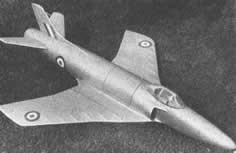 Albon Javelin, span 32", 24 oz.
- Aeromodeller, 1953
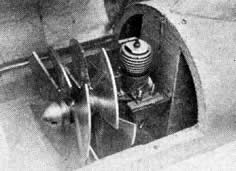
- Aeromodeller, 1953
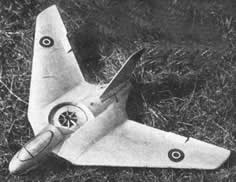 Albon Dart, span 24", 7½ oz.
- Aeromodeller, Mar. 1953
|
|||||||


One can see why Phil Smith and P E Norman preferred the axial fan. However, Gates concluded that the transverse centrifugal fan did have advantages, as a large diameter impeller could be put a small model: a thrust of 3½ oz from a 0.5cc motor was quoted as what could be expected. Curiously, it was not until the fifth of Model Aircraft’s six articles, ‘Jet Propulsion and the Model Aircraft’ (January-June 1956) that a vertically mounted centrifugal impeller was considered (see right). Model Aircraft comments: “The pressure rise that can be obtained from a single axial flow fan is quite small, it generally takes at least eight sets of axial fans to get the same pressure as can be achieved with a single centrifugal fan … a centrifugal blower then, appears a far more attractive proposition, but has disadvantages of being more complicated to make and more difficult to install. It also requires careful ducting … the most attractive solution appears to be to mount the blower on its side within an elementary form of plenum chamber, which exhausts into the tailpipe”. Impellers and small engines seem to have improved quite a lot between 1953 and 1956: according to this article up to 8 oz thrust could be obtained from an 049 engine driving a 3½" fan. |
|
 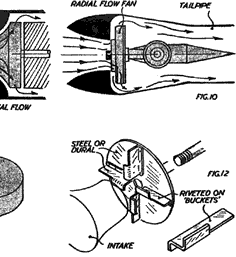
- Model Aircraft, June 1956
|
||||||
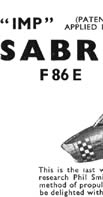
I was encouraged to see what appeared to be a replica of P E Norman’s 1953 Boulton Paul BP 120 flying very nicely at Middle Wallop recently. It didn’t seem noisy enough to be powered authentically by an Elfin 2.49, so I’m guessing it was EDF. Unfortunately I didn’t get to meet the gentleman responsible. If he is reading this, could he contact me? |
|
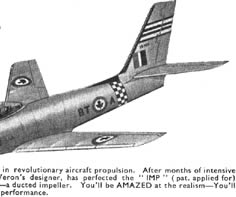
- Aeromodeller, 1956
|
||||||

The high performance of tiny glow motors presented another option to the innovative modeller. Grif Ingram sent me this very nice design for a Griffon II (right). This is less ducted fan’, more ‘shrouded propeller’ (made viable by the high-revving Pee Wee 02), but conversion to EDF should not be too difficult. Models smaller than this still present a considerable technical challenge. The F-107 ‘Ultra Sabre’ below (posted by a US modeller on the now defunct ModelJetPlane discussion group) is the size of a typical Jetex 50 model. The 1¼" diameter GW/EDF 30 is suitable for these models (if one can get one). A thrust of 0.74 oz. from 9.6 volts and one amp is claimed for this unit, and whilst this is equivalent to an L2 HP, the extra weight EDF entails will inevitably limit flight performance. More thrust is obviously needed to compensate. It is at this ‘micro EDF’ scale that Coatsworth’s techniques again begin to make sense. Centrifugal fan, anybody? |
|
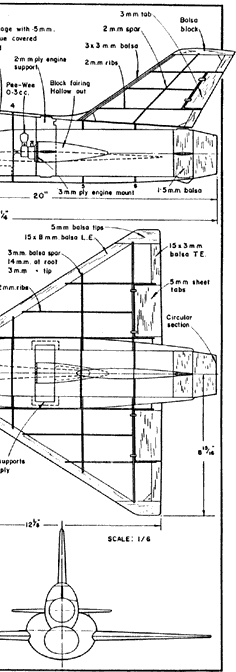
for Pee Wee 0.3 cc ducted fan |
||||||
|
|

- ModelJetPlane discussion group archives
|
||||||
|
|
||||||||
|
|
|
|||||||
|
|
|
|
|
|
|
|
Acknowledgements - Article: Roger Simmonds - Illustrations: Roger Simmonds, Grif Ingram, Howard Metcalfe, ModelJetPlane discussion group |
|
|
|
|
ABOUT | MOTORS | MODELS | ARCHIVE | HISTORY | STORE | FAQ | LINKS |
|
|
Terms of Use
|
Queries? Corrections? Additions?
Please
contact us.
|
|